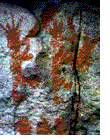
This article was originally published in Discover magazine in April 1997, as an April Fool's joke. So, please don't use it in an assignment, as did one unfortunate who indignantly emailed me after he received a failing grade. Return to my webpage about this article.
The most significant discovery in Oscar Todkopf's career was entirely serendipitous. Last April, the Hindenburg University paleontologist was hiking in Germany's Neander Valley when he tripped over something on a trail. Some quick digging exposed the obstacle as the tip of a mastodon tusk. But it wasn't until a few weeks later when the entire tusk was unearthed and dated that Todkopf realized the magnitude of his find. The tusk, he believes, was a Neanderthal musical instrument. Todkopf calls it a Neanderthal "tuba." Like the bone flute discovered in Slovenia last year, the 50,000-year-old tuba predates the presence of anatomically modern humans in Europe.
Sixteen carefully aligned holes dot the surface of the six-foot-long tusk. "I think a Neanderthal master craftsman must have used a stone awl to hollow out the tusk and to punch the holes," says Todkopf. The number of holes, he says, suggests that Neanderthals used an octave scale.
Todkopf also uncovered the remains of what appear to be at least three other instruments. One resembles a bagpipe. Although the "bag" part disintegrated long ago, it left a protein "stain" in the rock. Analysis suggests it was probably fashioned from the bladder of some large animal, perhaps a woolly rhinoceros, and was at one time attached to some long, thin bones found arrayed around the impression. Todkopf also found a delicate bone "triangle" and a collection of hollowed-out bones of various lengths.
"I think they were part of an instrument similar to a xylophone--I like to call it a xylobone," says Todkopf. "But a colleague thinks Neanderthals hung the bones at cave entrances like big wind chimes. As for the bagpipes, well, it doesn't surprise me that we have Neanderthals to thank for them." Todkopf believes they played the pipes with their noses. The bones found near the bladder stain are tipped with wooden plugs with hollow centers. The plugs, says Todkopf, fit perfectly into the sinus cavities of a Neanderthal skull found at the site. "These fellows had nasal cavities as big as beer halls," he says.

|
|
Todkopf theorizes that the Neanderthals' fondness for music may explain why they vanished some 30,000 years ago. "Maybe their music scared away all the game. They would have produced an awful racket oompah-pahing all over the place. The Neander Valley was alive with the sound of music."
Once again our readers proved themselve good sports, as evidenced by the letters that appeared in the July issue of Discover.
July 1997 - Letters: April Is the Cruelest Month
I WANT TO THANK DISCOVER FOR
continuing to seek out and dispel some of the myths that are
taught to be fact, such as in the Breakthroughs
section of the April issue.
As a longtime saxophone player I have always been taught that Adolphe Sax was the discoverer/inventor of the saxophone. The Neanderthal cave painting, specifically the figure on the left, obviously shows a saxophone (appears to be a tenor) being played, revealing that Mr. Sax may have been guilty of stealing ideas from early man.
Again, words cannot convey your straightening us out on this matter.
LARRY W. BADER
Columbia, Miss.
P.S. 1997 has been touted as the 150th anniversary of the
invention of the saxophone! Ha!
I WAS INTRIGUED BY THE WONDERFUL
Discovery made by Mr. Todkopf. I spoke with Mr. Todkopf, and
he related to me the finding of an additional item at the
site. The item was a crude AM radio. It was apparently
powered by a primitive solar collector. Mr. Todkopf
speculates that the radio was used to transmit the music
played by this amazing company of Neanderthals.
BOB NORTHRUP
Raleigh, N.C.
I AM PLEASED TO SEE THAT TODIE
(as we called him in seventh grade) is in a more respectable
line of research. I always found his monographs on
Mousterian "frijole bands" somewhat embarrassing. Have a
happy holiday.
DORIS BRODY
Bethesda, Md.
AL HIRSHFELD PUT A LITTLE NUMBER
next to his name to indicate how many times he'd enmeshed
his daughter's name in his illustrations.
I propose that DISCOVER do the same on the covers of its April issues.
JONATHAN MACY
Boston